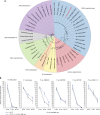Extreme sensitivity to ultraviolet light in the fungal pathogen causing white-nose syndrome of bats
- PMID: 29295979
- PMCID: PMC5750222
- DOI: 10.1038/s41467-017-02441-z
Extreme sensitivity to ultraviolet light in the fungal pathogen causing white-nose syndrome of bats
Abstract
Bat white-nose syndrome (WNS), caused by the fungal pathogen Pseudogymnoascus destructans, has decimated North American hibernating bats since its emergence in 2006. Here, we utilize comparative genomics to examine the evolutionary history of this pathogen in comparison to six closely related nonpathogenic species. P. destructans displays a large reduction in carbohydrate-utilizing enzymes (CAZymes) and in the predicted secretome (~50%), and an increase in lineage-specific genes. The pathogen has lost a key enzyme, UVE1, in the alternate excision repair (AER) pathway, which is known to contribute to repair of DNA lesions induced by ultraviolet (UV) light. Consistent with a nonfunctional AER pathway, P. destructans is extremely sensitive to UV light, as well as the DNA alkylating agent methyl methanesulfonate (MMS). The differential susceptibility of P. destructans to UV light in comparison to other hibernacula-inhabiting fungi represents a potential "Achilles' heel" of P. destructans that might be exploited for treatment of bats with WNS.
Conflict of interest statement
The authors declare no competing financial interests.
Figures





Similar articles
-
Pseudogymnoascus destructans transcriptome changes during white-nose syndrome infections.Virulence. 2017 Nov 17;8(8):1695-1707. doi: 10.1080/21505594.2017.1342910. Epub 2017 Jul 13. Virulence. 2017. PMID: 28614673 Free PMC article.
-
Phylogenetic evaluation of Geomyces and allies reveals no close relatives of Pseudogymnoascus destructans, comb. nov., in bat hibernacula of eastern North America.Fungal Biol. 2013 Sep;117(9):638-49. doi: 10.1016/j.funbio.2013.07.001. Epub 2013 Jul 11. Fungal Biol. 2013. PMID: 24012303
-
Nonlethal screening of bat-wing skin with the use of ultraviolet fluorescence to detect lesions indicative of white-nose syndrome.J Wildl Dis. 2014 Jul;50(3):566-73. doi: 10.7589/2014-03-058. Epub 2014 May 22. J Wildl Dis. 2014. PMID: 24854396
-
Investigating and managing the rapid emergence of white-nose syndrome, a novel, fatal, infectious disease of hibernating bats.Conserv Biol. 2011 Apr;25(2):223-31. doi: 10.1111/j.1523-1739.2010.01638.x. Epub 2011 Feb 1. Conserv Biol. 2011. PMID: 21284732 Review.
-
Involvement of DNA damage and repair in mutational spectra.Mutat Res. 2000 May 30;450(1-2):1-3. doi: 10.1016/s0027-5107(00)00012-9. Mutat Res. 2000. PMID: 10838130 Review. No abstract available.
Cited by
-
Development of a multi-year white-nose syndrome mitigation strategy using antifungal volatile organic compounds.PLoS One. 2022 Dec 1;17(12):e0278603. doi: 10.1371/journal.pone.0278603. eCollection 2022. PLoS One. 2022. PMID: 36454924 Free PMC article.
-
Gaussian process forecasts Pseudogymnoascus destructans will cover coterminous United States by 2030.Ecol Evol. 2022 Nov 27;12(11):e9547. doi: 10.1002/ece3.9547. eCollection 2022 Nov. Ecol Evol. 2022. PMID: 36447592 Free PMC article.
-
Beyond White-Nose Syndrome: Mitochondrial and Functional Genomics of Pseudogymnoascus destructans.J Fungi (Basel). 2025 Jul 24;11(8):550. doi: 10.3390/jof11080550. J Fungi (Basel). 2025. PMID: 40863502 Free PMC article.
-
Evaluation of Virus-Free and Wild-Type Isolates of Pseudogymnoascus destructans Using a Porcine Ear Model.mSphere. 2022 Apr 27;7(2):e0102221. doi: 10.1128/msphere.01022-21. Epub 2022 Mar 21. mSphere. 2022. PMID: 35306863 Free PMC article.
-
Forgotten fungi: the importance of the skin mycobiome.Curr Opin Microbiol. 2022 Dec;70:102235. doi: 10.1016/j.mib.2022.102235. Epub 2022 Nov 11. Curr Opin Microbiol. 2022. PMID: 36372041 Free PMC article. Review.
References
-
- Gargas A, Trest MT, Christensen M, Volk TJ, Blehert DS. Geomyces destructans sp. nov. associated with bat white-nose syndrome. Mycotaxon. 2009;108:147–154. doi: 10.5248/108.147. - DOI
Publication types
MeSH terms
Substances
LinkOut - more resources
Full Text Sources
Other Literature Sources
Medical
Molecular Biology Databases

